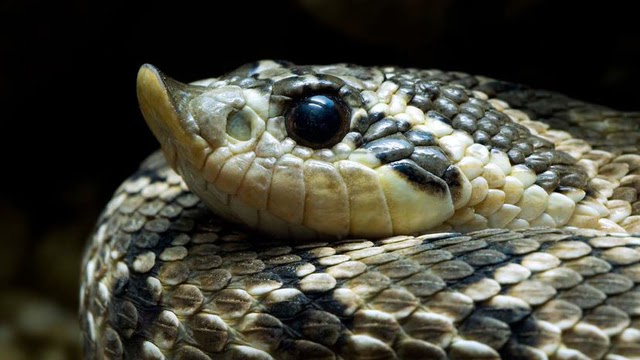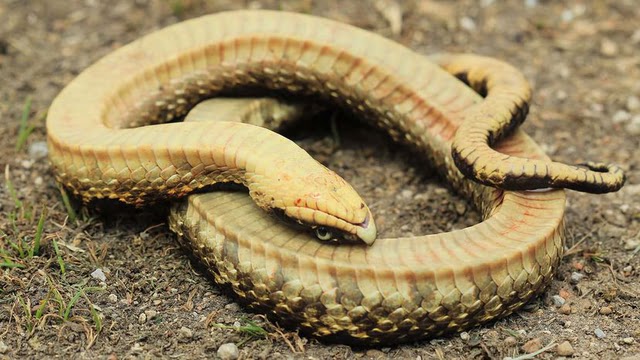Quck answer
Hognose snakes have a unique defense mechanism – they play dead like opossums. When threatened, they will flatten their bodies, hiss loudly, and then flip over onto their backs and play dead. They will even go as far as to excrete a foul-smelling liquid and release their bowels to make themselves appear dead. This tactic works well against predators, as they will often lose interest in what they believe to be a dead snake. However, if the threat persists, the hognose snake will quickly return to its normal position and continue its defense.
Wild Animals

The upturned snout of the western hognose (Heterodon nasicus) snake reveals why it is called “hognose.” Arterra/Universal Images Group/Getty Images
Virginia opossums (Didelphis virginiana) are not the only ones who pretend to be dead when they feel threatened. Many small, slow-moving animals use thanatosis as a survival strategy when they cannot fight or flee from larger predators. This includes some species of vertebrate animals, such as reptiles.
The hognose snakes in North America are known for their impressive acting skills in imitating death. These snakes belong to the genus Heterodon, which also includes species in Madagascar and South America, but they are classified separately. Hognose snakes have upturned noses that help them search for food by pushing aside dirt, sand, and leaf litter.
Wild Hogs
The Heterodon snakes are found from the Eastern Seaboard of the United States to Arizona and the Rocky Mountains, as far north as central Canada, and as far south as San Luis PotosГ, Mexico. The genus includes three species, including the eastern hognose, southern hognose, and western or “plains” hognose. The eastern hognose is the largest of the three, growing up to 46 inches in length.
Hognose snakes eat meat, primarily toads, which they immobilize with mild venom from their large fangs. Some naturalists speculate that Heterodon snakes might puncture the lungs of toads to deflate them for easier swallowing, but this has not been confirmed. Hognose snakes also eat fish, lizards, rodents, salamanders, small birds, eggs, and invertebrates like earthworms.

The eastern hognose snake is known for its dramatic display of playing dead when threatened. It writhes around, emits a foul odor, and lies upside down as if dead. Barcroft Media/Getty Images
Feeding Time
Toads have their own anti-predator defenses, such as puffing themselves up to appear larger. However, hognose snakes may be able to counter this by puncturing the lungs of the toads they consume, making them easier to swallow.
The diet of the western hognose snake may vary as it ages, according to a study conducted in 2017 on wild specimens from Illinois. The chemical analysis revealed that juvenile snakes eat racerunner lizards and their eggs, while adults prefer turtle eggs.
These snakes are susceptible to predators such as hawks, opossums, raccoons, foxes, and other snakes, including the cottonmouth. When threatened, eastern hognose snakes flatten their necks, hiss, and rear up to intimidate their enemies. However, their fangs are not positioned for effective venom delivery, so they seldom bite their attackers.
Hognose snakes are famous for playing dead when they feel threatened, a behavior known as thanatosis. During this act, the snake will writhe around before going belly-up with its mouth open and tongue out, sometimes regurgitating food, and even defecating. This fecal matter may contain bufotoxin, a poison from the toads that the snakes eat, that could repel other animals.
The purpose of this behavior is unclear, but it is innate in hognose snakes, even in hatchlings. Some adult eastern hognoses were observed faking their own deaths while mating, with the female breaking character before her partner did, dragging him behind her while they continued to copulate.
Hognose snakes are easily kept in captivity, and they make great pets. They rarely bite larger creatures, including humans, and their venom is not dangerous, though it can cause blisters, swelling, and other symptoms. However, they may bite if they smell food on their owner’s fingers, so it is essential to wash hands before interacting with them.
FAQ
1. What are Hognose snakes?
Hognose snakes are a species of non-venomous snakes found in North America. They are known for their distinctive upturned nose, which gives them their name.
2. Why do Hognose snakes play dead?
Hognose snakes play dead as a defense mechanism. When threatened, they will flatten their bodies, open their mouths, and release a foul odor to convince predators that they are dead and not worth eating.
3. How long can Hognose snakes play dead?
Hognose snakes can play dead for up to an hour or more. They will remain motionless and unresponsive, even if touched or moved.
4. Do all Hognose snakes play dead?
No, not all Hognose snakes play dead. It is a behavior that is more commonly observed in Eastern Hognose snakes, while Western Hognose snakes are less likely to play dead.
5. Is playing dead the only defense mechanism of Hognose snakes?
No, Hognose snakes have other defense mechanisms as well. They may hiss, strike, or flatten their bodies to appear larger when threatened.
6. Can Hognose snakes be kept as pets?
Yes, Hognose snakes can be kept as pets. They are relatively easy to care for and come in a variety of colors and patterns. However, it is important to research their specific care requirements before getting one as a pet.





Leave a Reply